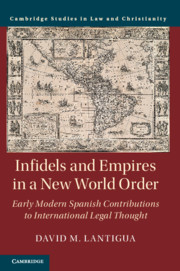 Infidels and Empires in a New World Order
Infidels and Empires in a New World Order from Part I - The New World Crucible of Infidel Rights
Published online by Cambridge University Press: 11 June 2020
The question of rights for non-Christians emerged out of a theocratic papalist conception of world order during the medieval crusades typified by the canon lawyer Sinibaldo Fieschi (later Pope Innocent IV). It then informed the dominant and ambivalent legal view of Christian-infidel relations in Latin Christendom represented in very different ways by both Innocent IV and his creative commentator, Polish jurist Paulus Vladimiri. This chapter considers the political translation of Innocent’s canon legal opinion on Christian-infidel relations to support the Iberian cause of missionary war in spreading the faith through Crown and Empire across the Atlantic. Theocratic world order, as articulated by Spanish royal jurists and conquistadors like Juan López de Palacios Rubios and Hernán Cortés, chiefly rested its justification for European expansion on the right of punishing infidels for their violation of natural law, the sin of idolatry above all. Infidels had dominium, in principle, but Europeans could claim superior jurisdiction over them when they presented obstacles to the spreading of religion and civilization.
To save this book to your Kindle, first ensure [email protected] is added to your Approved Personal Document E-mail List under your Personal Document Settings on the Manage Your Content and Devices page of your Amazon account. Then enter the ‘name’ part of your Kindle email address below. Find out more about saving to your Kindle.
Note you can select to save to either the @free.kindle.com or @kindle.com variations. ‘@free.kindle.com’ emails are free but can only be saved to your device when it is connected to wi-fi. ‘@kindle.com’ emails can be delivered even when you are not connected to wi-fi, but note that service fees apply.
Find out more about the Kindle Personal Document Service.
To save content items to your account, please confirm that you agree to abide by our usage policies. If this is the first time you use this feature, you will be asked to authorise Cambridge Core to connect with your account. Find out more about saving content to Dropbox.
To save content items to your account, please confirm that you agree to abide by our usage policies. If this is the first time you use this feature, you will be asked to authorise Cambridge Core to connect with your account. Find out more about saving content to Google Drive.